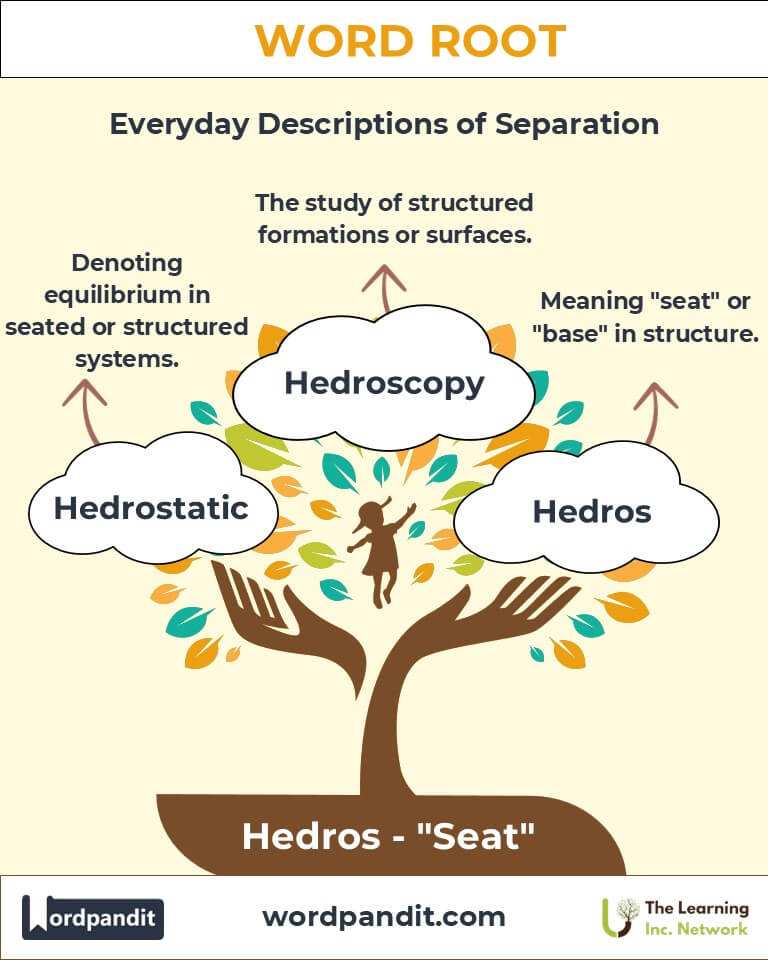Table of Contents
- Introduction: The Essence of "Hedros"
- Etymology and Historical Journey
- Mnemonic: Unlocking the Power of "Hedros"
- Common Hedros-Related Terms
- Hedros Through Time
- Hedros in Specialized Fields
- Illustrative Story: "Hedros" in Action
- Cultural Significance of "Hedros"
- The "Hedros" Family Tree
- FAQs about the "Hedros" Word Root
- Test Your Knowledge: "Hedros" Mastery Quiz
- Conclusion: The Living Legacy of "Hedros"

1. Introduction: The Essence of "Hedros"
What do geometric solids and anatomical cavities have in common? The answer lies in the root "hedros," meaning "seat." This ancient term resonates across disciplines, describing structures with defined boundaries or fixed forms. From the rigid planes of a polyhedron to the spatial relevance of a hedrocele in anatomy, "hedros" embodies the concept of foundational structure.
Pronunciation: HED-ross
Meaning: Seat (Latin and Greek origins).

2. Etymology and Historical Journey
The root "hedros" has its origins in ancient Greek, where it referred to a "seat" or "base," symbolizing stability and position. Over time, it became foundational in geometry, describing the "faces" or "seats" of three-dimensional shapes like polyhedrons. In anatomy, it evolved to denote structural cavities or spaces, preserving its sense of being a "resting" place.
3. Mnemonic: Unlocking the Power of "Hedros"
Imagine a solid chair with multiple faces, symbolizing both a geometric polyhedron and a structural seat in anatomy.
Mnemonic Device: "Hedros holds its place, whether in shapes or spaces."
4. Common Hedros-Related Terms
- Polyhedron (pol-ee-HEE-dron): A three-dimensional shape with flat polygonal faces.
Example: "A cube is a simple polyhedron with six square faces." - Hedrocele (HED-roe-seel): A cavity or space within the body, often described in medical contexts.
Example: "The patient’s diagnosis involved a rare form of hedrocele in the abdominal cavity." - Tetrahedron (tet-rah-HEE-dron): A polyhedron with four triangular faces.
Example: "The tetrahedron is the simplest form of a polyhedron." - Icosahedron (eye-kos-ah-HEE-dron): A polyhedron with 20 triangular faces.
Example: "The icosahedron is a popular shape in geometric modeling."
5. Hedros Through Time
- Ancient Geometry: Early Greek mathematicians like Euclid used "hedros" to describe the faces of solids, paving the way for modern geometry.
- Medical Advancements: In anatomy, "hedros" evolved to signify cavities or spaces, highlighting its adaptability in describing physical structures.
6. Hedros in Specialized Fields
- Geometry: Polyhedron: Central to understanding three-dimensional forms in mathematics and architecture.
- Medicine: Hedrocele: Applied in diagnosing and describing abnormal bodily cavities.
- Physics: Tetrahedron: Integral in visualizing molecular structures and forces in quantum physics.
7. Illustrative Story: "Hedros" in Action
In a bustling geometry class, Maya struggled to grasp the concept of a polyhedron. Her teacher asked her to imagine a cube as a sturdy "seat" for understanding its six faces. Meanwhile, in a nearby hospital, a radiologist explained a hedrocele to a patient, using the same analogy of a structured space within the body. This connection between math and medicine highlighted the versatile legacy of "hedros."
8. Cultural Significance of "Hedros"
From the geometric precision of ancient Greek art to its medical applications in modern diagnostics, "hedros" reflects humanity's quest for structure and understanding. It bridges abstract forms and tangible spaces, inspiring innovation in both art and science.

9. The "Hedros" Family Tree
- Hedra- (Greek: base or seat): Hedron: A solid geometric figure.
- Cav- (Latin: hollow): Cavity: An empty space within a solid.
- Fac- (Latin: face): Facet: A small, flat surface on a geometric solid or gemstone.
FAQs About the Hedros Word Root
Q1: What does "hedros" mean?
A: The root "hedros" means "seat" or "base," originating from Greek. It metaphorically represents a foundation or a resting place. In geometry, it refers to the faces of polyhedrons, which act as "seats" for the overall shape. In anatomy, it describes spaces or cavities that "seat" various bodily components.
Q2: How is "hedros" used in geometry?
A: In geometry, "hedros" appears in terms like "polyhedron," where it refers to the flat faces of a three-dimensional shape. Each face, or "seat," contributes to the overall structure. For example, a cube has six square faces, making it a polyhedron.
Q3: What is a hedrocele?
A: In medical terminology, a "hedrocele" is a cavity or abnormal space within the body. The term combines "hedros" (seat or cavity) with "cele" (swelling or pouch). It is often used in clinical contexts to describe structural abnormalities.
Q4: Why is the concept of "hedros" significant in anatomy?
A: "Hedros" is significant in anatomy because it helps describe the spatial organization of the body. Cavities and spaces, such as the abdominal cavity or cranial cavity, provide a "seat" for vital organs. This structural understanding is essential for studying bodily functions and diagnosing abnormalities.
Q5: How does "hedros" connect geometry and anatomy?
A: In geometry, "hedros" describes the faces of solid shapes, while in anatomy, it refers to cavities or spaces. Both applications rely on the idea of defining boundaries or stable structures. This shared concept illustrates the root’s versatility across abstract and physical domains.
Q6: What is the difference between a polyhedron and a tetrahedron?
A: A polyhedron is a general term for any three-dimensional shape with flat polygonal faces, such as cubes or pyramids. A tetrahedron, specifically, is a type of polyhedron with exactly four triangular faces, making it the simplest example of this category.
Q7: Is "hedros" still relevant in modern science?
A: Absolutely! In geometry, "hedros" is used to describe three-dimensional solids, which are essential in fields like architecture, design, and mathematics. In medicine, understanding cavities (hedrocele) is crucial for diagnostics, surgery, and research.
Test Your Knowledge: Hedros Word Root Quiz
1. What does the root "hedros" signify?
2. Which of the following is a polyhedron?
3. What does "hedrocele" describe?
4. Which polyhedron has four faces?
5. What is the root origin of "hedros"?

12. Conclusion: The Living Legacy of "Hedros"
The root "hedros" weaves a fascinating narrative across geometry and anatomy, connecting the abstract with the tangible. Whether visualizing a polyhedron or diagnosing a hedrocele, this ancient root continues to provide a "seat" for understanding in diverse fields. As science and art evolve, "hedros" remains a symbol of stability, form, and structure.











